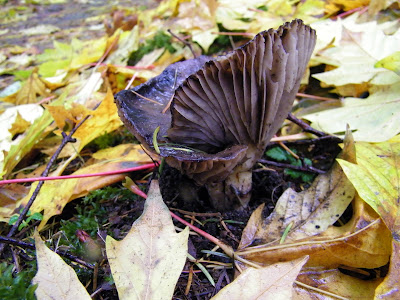I have two guide-books, each with their own strengths and weaknesses.
"Mushrooms Demystified," by David Arora, is a magnificent book, the best-written field guide of any kind that I have ever encountered. Arora has a strong and amusing authorial voice, the book is crammed with info. On the minus side, it is ancient. The most recent edition is from 1986. And most of the pictures are in black and white. Plus, it's California-centric.
My other guide, "Mushrooms of the Pacific Northwest" by Steve Trudell and Joe Ammirati was published in 2009, and it's as local as they come (both authors teach at the University of Washington. It's not as comprehensive as Arora's book, and well, it isn't written by Arora.
Along with these books, I can turn to the Internet, which can be helpful sometimes.
So let's see how I do with these mushrooms I encountered on Tuesday's soggy walk.

These were hard, woody, and browner than they look in the picture. I think it's a polypore, but I don't see anything that looks like it in the polypore chapter of Trudell and Ammirati.
In Arora, I follow the key to Piptoporus & Cryptoporus. Looks like Cryptoporus volvatus is a possibility.
Arora writes:
"This bizarre evolutionary anomaly looks like a cross between a confused puffball and a bemused oak gall. The smooth, warmly tanned exterior is quite attractive (often reminding me of a small loaf of bread) and gives no hint of the tube layer within. Slicing it open, however, reveals a hollow interior with a "ceiling" of tubes. The "floor" eventually ruptures and tiny bark-boring beetls enter the "trap door" in search of tasty tube tissue and spores. After feasting they depart to construct brood tunnels in old or dying conifers, and the spores they carry with them gain entry to a new host. Later, fruiting bodies may emerge through the very holes bored by the beetles!"
Cool.
Next step: Google Cryptoporus volvatus. Hey look: it's still called that.
One problem: it grows on conifer wood, and I'm pretty sure that's an alder log.

These were growing in a crowd, and I can't resist red. One broke when I was looking at the gills, but I didn't notice any latex. (I wasn't looking for it though, so that doesn't mean there wasn't any.) They look like Lactarius subflammeus in Trudell and Ammirati, and they're consistent with the description in Arora, and there are pictures that look like them online. So: Lactarius subflammeus. I think.

This is a bolete. The gills are tubular and yellow-green, and when I poke them with my fingernail, they don't turn gray. Looking at Trudell and Ammirati. I think it the cap seems more like B. Zelleri, but neither one has seems to have that green stipe. Turning to Arora, who appears to have a thing for boletes, I'm leaning toward Zelleri -- for one thing Arora says the tubes often don't stain blue.

As usual, the things I notice about this mushroom are not necessarily the things that are likely to help me identify it. What I notice: it's big, and funnel shaped with this nifty wrap-around thing going on. What I should have figured out: the spore color, as it's how Trudell and Ammirati sort out the gilled mushrooms, whether the flesh is brittle or not, and whether or not it smelled of grape bubble gum. If it did, it may have been Clitocybe clavipes.

There were a bunch of these handsome white mushrooms under a cedar tree. I think it's a Russula. Which one, I can't tell. I might have a chance if I looked at the spores under a microscope.
No comments:
Post a Comment